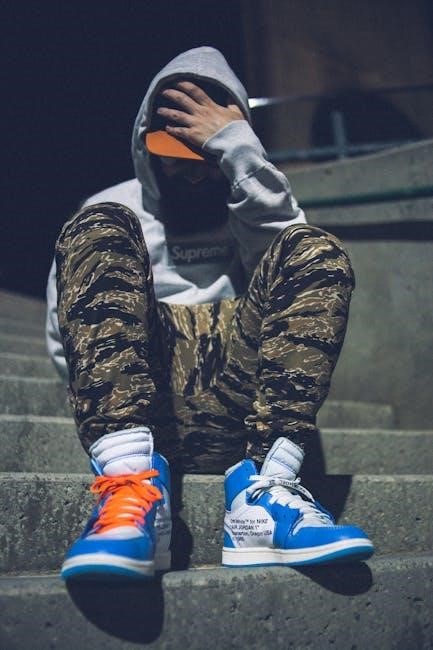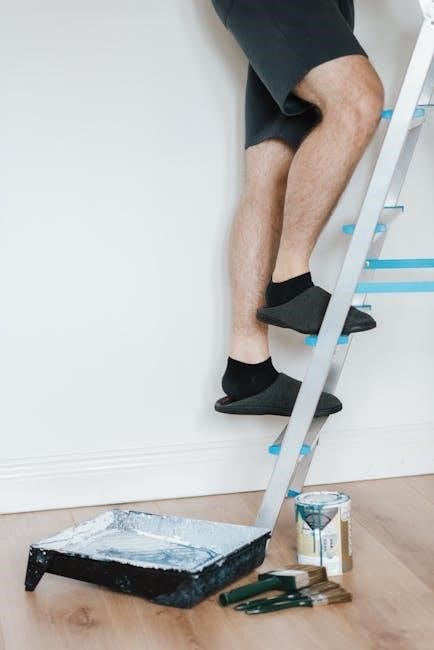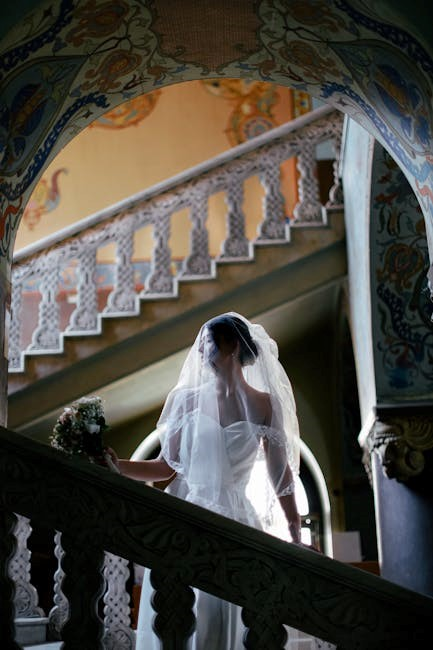Face painting is a vibrant art form that transforms faces into colorful canvases, offering endless creativity and self-expression. Popular worldwide, it enhances celebrations, festivals, and everyday fun, inviting both kids and adults to embrace their imagination and uniqueness through dynamic designs.
1.1 What is Face Painting?
Face painting is a creative art form that involves applying paint or makeup to transform a person’s face into a unique design or character. Using water-activated paints, sponges, and brushes, artists create vibrant, temporary designs that range from simple patterns to intricate, lifelike imagery. This popular activity is often seen at festivals, parties, and events, appealing to both children and adults. It allows individuals to express their personality, embrace a theme, or simply enjoy a fun, artistic experience. Face painting combines artistry, imagination, and interaction, making it a beloved activity worldwide. The process is both therapeutic and transformative, bringing joy to those who participate.
1.2 Why is Face Painting Popular?
Face painting has gained immense popularity due to its universal appeal and versatility. It allows individuals to express their creativity, embrace themes, or simply enjoy a fun, artistic experience. The temporary nature of face painting makes it a risk-free way to transform one’s appearance, appealing to both children and adults. Its popularity is also fueled by its presence at festivals, parties, and events, where it serves as a form of entertainment and self-expression. Additionally, the ease of learning basic techniques and the availability of tutorials have made it accessible to all skill levels, further contributing to its widespread popularity and enjoyment.

Face Painting Supplies
Essential supplies include face paint, sponges, and brushes. Optional items like stencils, glitter, and sealers enhance designs. Quality products ensure safety and vibrant, long-lasting results for artists.
2.1 Essential Supplies for Face Painting
Face painting requires a few key supplies to get started. First, choose high-quality, non-toxic face paints from reputable brands like Wolfe FX, Diamond FX, or Kryvaline. These paints are safe for skin and provide vibrant colors. A good set of brushes is also essential—flat brushes for base colors and fine brushes for details. Sponges are ideal for applying large areas of color quickly and smoothly. Additionally, you’ll need water cups for thinning paint, a palette or container for mixing, and paper towels for cleaning. A small mirror can help the person being painted see the design as it progresses. Lastly, baby wipes or makeup remover are handy for cleaning up smudges or removing paint after the design is complete.
2.2 Optional Supplies for Advanced Designs
For more intricate designs, consider adding stencils, airbrushes, or metallic paints to your kit. Stencils can help create sharp, precise patterns, while airbrushes allow for smooth gradients and fine details. Metallic and glitter paints add a shimmering effect, perfect for capturing light and adding depth. Rhinestones or gems can be applied for extra sparkle, and UV-reactive paints create glowing effects under black light. Additionally, specialized brushes, like fine liners or mottling brushes, can enhance detail work. These supplies are optional but can elevate your designs, making them more professional and visually striking. Experiment with these tools to explore advanced techniques and unique effects in your face painting journey.

Preparation and Safety
Ensure the skin is clean and dry before painting. Use non-toxic, hypoallergenic paints and perform a patch test. Avoid sensitive areas to prevent irritation or allergic reactions.
3.1 Preparing the Skin for Face Painting
Preparing the skin is essential for a safe and successful face painting experience. Start by ensuring the skin is clean and dry, free from oils or makeup. This helps the paint adhere evenly and prevents smudging. If the skin is sensitive, perform a patch test with a small amount of paint on a discreet area, like the wrist, to check for any allergic reactions. Allow the test area to sit for at least 30 minutes before proceeding. If no irritation occurs, you’re ready to begin. Avoid painting over cuts, irritation, or sensitive areas to maintain comfort and hygiene.
3.2 Safety Guidelines for Face Paints
Ensuring safety is crucial when using face paints. Always opt for FDA-compliant, hypoallergenic products suitable for skin use. Avoid paints containing harmful chemicals like lead or mercury. Perform a patch test on a small area before applying to check for allergic reactions. Use clean, sanitized tools and avoid sharing sponges or brushes to prevent cross-contamination. Keep paints away from open wounds or sensitive areas. Store face paints in a cool, dry place and follow expiration dates. Dispose of expired products responsibly. For children, use kid-friendly, non-toxic formulas and supervise application closely. Prioritize hygiene and safety to create a positive, risk-free face painting experience.

Basic Face Painting Techniques
Master essential techniques like dabbing with sponges for base colors, using brushes for details, and creating fine lines for intricate designs to achieve stunning, professional-looking results.
4.1 Dabbing with a Sponge
Dabbing with a sponge is a fundamental technique in face painting, ideal for creating smooth, even base colors. Dip the sponge into the paint and gently press it onto the skin, ensuring consistent coverage. This method is perfect for large areas, such as the background or full-face designs. To achieve a seamless blend, use light, tapping motions, gradually building up the color. Remember to clean the sponge between colors to avoid mixing hues. With practice, this technique becomes a cornerstone for any face painting project, offering a professional finish that enhances your overall design.
4.2 Using Brushes for Details
Using brushes for details is essential for adding precision and finesse to your face painting designs. Fine-tip brushes are ideal for creating intricate lines, outlines, and small features, while round brushes work well for shading and filling in small areas. To achieve crisp details, dip the brush in paint, wipe off excess on the edge of the container, and apply gentle, controlled strokes. For delicate lines, hold the brush at an angle, using the tip for accuracy. Regularly clean your brushes between colors to maintain sharp, vibrant details. Practice with different brush types and pressures to master the art of detailed face painting.
4.3 Creating Fine Lines
Creating fine lines requires precision and a steady hand. Use a fine-tip brush with minimal paint to ensure sharp, clean lines. Hold the brush at a slight angle, applying gentle pressure. Practice on a separate surface first to gauge the flow of paint. For straight lines, use a ruler or guide. Short, controlled strokes work best for curved lines. Start with light pressure and build up as needed. Avoid overloading the brush with paint, as this can lead to smudging. Clean the brush frequently to maintain accuracy. With practice, you’ll master the art of creating crisp, professional fine lines in your designs.
Step-by-Step Face Painting Guide
Master face painting with a step-by-step approach, starting with base colors, adding details, and finishing with touches that bring your design to life creatively.
5.1 Step 1: Applying the Base Color
Start by applying the base color using a sponge or brush. Dip the sponge into the paint and gently dab it onto the skin for a smooth, even layer. For beginners, use simple colors like red, black, and white to create a foundation. Ensure the skin is clean and dry for better adhesion. Use light, even strokes with a brush for smaller areas. This step sets the tone for your design, allowing details to stand out later. Always opt for FDA-compliant paints to ensure safety. Properly preparing the skin beforehand enhances the paint’s durability and finish, making this step crucial for a professional look.
5.2 Step 2: Adding Details and Patterns
Switch to a fine brush for intricate details, holding it at an angle for precise strokes. Vary line thickness to add depth and dimension. Use stencils or freehand to create patterns like swirls or dots. For textures, dab with a sponge or layer colors for depth. Add elements such as stars or leaves for a polished look. Ensure all paints are FDA-compliant for safety. Blend colors gently for a seamless finish, enhancing the overall design. This step transforms the base into a vibrant, detailed masterpiece, showcasing your creativity and skill. Pay attention to symmetry and balance for a professional appearance.
5.3 Step 3: Finishing Touches
Inspect the design for balance and symmetry, making minor adjustments as needed. Add highlights using white or metallic paints for depth and dimension. Use a fine brush to refine details, ensuring crisp lines and sharp edges. Blend colors gently with a damp brush to soften harsh lines. Apply a final coat of sealant to protect the design and prevent smudging. For a polished look, ensure all elements are cohesive and well-integrated. Allow the paint to set completely before touching or exposing to moisture. This final step completes the transformation, leaving a durable and professional finish that lasts throughout the event or celebration.
Popular Face Painting Designs
Popular designs include butterflies, rainbows, tigers, and superheroes, offering creative options for all skill levels and occasions, from simple to intricate, ensuring something for everyone.
6.1 Simple Designs for Beginners
Simple designs are perfect for new face painters, focusing on basic shapes and minimal details. Common designs include rainbows, hearts, stars, and animal faces like butterflies or ladybugs. These designs are great for practicing essential techniques like color blending and line work. They require minimal supplies and are quick to create, making them ideal for events with large crowds. Beginners can start with single-color designs or gradient effects, gradually adding details as they gain confidence. These designs are forgiving, allowing for small mistakes, and help build foundational skills. Practice on paper first to refine your strokes before painting on skin for the best results.
6.2 Advanced Designs for Seasoned Artists
Advanced face painting designs offer seasoned artists the opportunity to showcase intricate details and creative complexity. Techniques like layering, blending, and 3D effects allow for realistic and visually stunning designs. Popular advanced designs include elaborate animal faces, such as tigers or wolves, skeletal patterns, and fantasy creatures like dragons or unicorns. These designs require precision and patience, often involving multiple steps and color transitions. Artists can also explore themed designs, such as superheroes, princesses, or mythical beings, to cater to specific events or client requests. Mastery of these designs enhances an artist’s portfolio and demonstrates their skill in transforming faces into works of art.
Face Painting for Special Occasions
Face painting brightens special occasions, offering unique designs for Halloween, Christmas, and Easter. Popular themes include superheroes and princesses, inspiring creativity for every event and bringing joy to all ages.
7.1 Halloween Face Painting Ideas
Halloween face painting offers spooky yet fun designs, from ghosts and witches to pumpkins and zombies. Popular themes include black cats, bats, and spiders. For kids, friendly options like superheroes or princesses with a Halloween twist are ideal. Advanced designs might feature skulls, skeletons, or vampires, while simpler looks like stripes or glow-in-the-dark effects are quick and impressive. Step-by-step guides often recommend starting with a base color, adding details, and finishing with highlights. These designs bring Halloween spirit to life, making it a favorite for creative expression and festive celebrations.
7.2 Christmas and Easter-Themed Designs
Christmas and Easter face painting designs are perfect for festive celebrations. For Christmas, popular ideas include snowflakes, reindeer, Santa hats, and holly patterns. Easter designs often feature bunnies, eggs, flowers, and crosses. These themes are great for holiday events, offering a fun way to embrace the spirit. Step-by-step guides suggest starting with a base color, adding details like eyes or patterns, and finishing with highlights. Both holidays allow for creative expression, from simple to intricate designs, making them a hit for all ages. These festive looks are ideal for capturing the joy and magic of the season in a unique and artistic way.
7.3 Superhero and Princess Designs
Superhero and princess face painting designs are crowd-pleasers, especially for kids. Superheroes often feature bold colors and iconic symbols, like Superman’s “S” or Batman’s logo, while princess designs include tiaras, flowers, and soft, elegant patterns. These designs allow for creativity and can be tailored to match favorite characters. Step-by-step guides recommend starting with a base color, then adding details like masks or jewels. Princess designs might involve delicate strokes for hair or crowns, while superheroes focus on strong lines and dynamic symbols. Both themes are perfect for empowering kids and creating memorable looks, blending fantasy with artistry.

Animal and Fantasy Designs
Animal and fantasy designs bring creativity to life, offering popular choices like butterflies, tigers, and magical creatures. These designs inspire artistic expression and imaginative transformations, perfect for all ages.
8.1 Butterfly and Rainbow Designs
Butterfly and rainbow designs are timeless favorites, blending vibrant colors and delicate patterns for a magical look. Start by applying a gradient base with a sponge, transitioning from soft pinks to blues. Use a one-stroke brush to create butterfly wings, ensuring smooth, flowing lines. Add intricate details like antennae with a fine brush. For rainbows, layer colors side by side, blending gently for a seamless effect. These designs are perfect for beginners and experienced artists alike, offering endless creativity. Practice makes perfect, so experiment with different color combinations and techniques to master these stunning looks. Ideal for festivals, parties, or everyday fun, these designs inspire joy and self-expression.
8.2 Tiger and Skeleton Face Painting
Tiger and skeleton designs are crowd-pleasers, offering bold contrasts and dramatic effects. For a tiger, use a sponge to apply orange and black stripes, blending edges for a natural look. A fine brush adds details like whiskers and eyes. Skeletons require precise line work; start with a black base, then paint white bones. Add shading for depth and dimension. Both designs are great for Halloween or themed events. Practice layering and blending to achieve realistic results. These designs are perfect for all skill levels, with step-by-step guides available for mastering the techniques. They’re ideal for creating striking, memorable looks that captivate audiences of all ages.
Tips for Fast and Impressive Designs
Use sponges for quick base colors and fine brushes for details. Layer colors and blend edges for depth. Practice simple strokes to speed up your process.
9.1 Quick and Easy Face Painting Ideas
Start with simple designs like stripes, dots, or shapes using a sponge or brush. Essential supplies include face paint, a sponge, and basic colors. For quick results, use stencils or stamps to create patterns. Layering and blending colors can add depth without complexity. Try a tiger stripe or butterfly wing for a fast, impressive look. Use fine brushes for details like eyes or outlines. Practice basic strokes to speed up your process. Keep a steady hand and watch tutorials for inspiration. These ideas are perfect for beginners or large crowds, ensuring everyone leaves with a smile and a memorable design.
9.2 How to Paint Fast for Large Crowds
To paint efficiently for large crowds, focus on simple, repeatable designs like stripes, dots, or animal faces. Use sponges for quick base colors and brushes for details. Pre-plan a few fast designs to minimize decision fatigue. Keep a clean workspace with essential supplies within reach. Limit color changes to save time. Practice basic strokes to maintain speed and consistency. Use stencils or stamps for intricate patterns without slowing down. Consider offering a menu of 3-5 quick designs to streamline the process. Work in small, controlled movements to avoid mistakes. With practice, you can paint up to 20 faces per hour, keeping everyone happy and engaged.

Troubleshooting Common Mistakes
Common mistakes include smudges and uneven color application. Use clean brushes, proper supplies, and practice to avoid errors. Regularly clean tools to maintain hygiene and performance.
10.1 Fixing Smudges and Errors
Fixing smudges and errors is crucial for achieving professional results. Start by gently blotting the area with a clean, damp brush or sponge to remove excess paint. For detailed corrections, use a fine brush dipped in makeup remover or a contrasting color to cover mistakes seamlessly. Avoid rubbing too hard to prevent skin irritation. Regularly cleaning your tools ensures better control and reduces the likelihood of smudging. Practice on paper or a practice pad to improve precision and minimize errors. With patience and the right techniques, even the most noticeable smudges can be corrected effectively.
10.2 Maintaining Your Face Painting Tools
Proper maintenance of face painting tools ensures longevity and hygiene. Clean brushes and sponges with mild soap and water after each use, reshaping brushes to maintain their form. Store supplies in a dry, clean environment to prevent mold and bacterial growth. Regularly sanitize tools with alcohol or sanitizing sprays, especially between uses on different individuals. Organize your kit to avoid damage and ensure easy access. Replace worn-out sponges and brushes promptly to maintain quality results. Proper care not only extends the life of your tools but also guarantees safe and professional applications. Invest in a sturdy storage case to protect your supplies during travel or storage.

Advanced Techniques
Advanced techniques elevate face painting to new artistic heights, focusing on layering, blending, and creating 3D effects. These methods allow for intricate designs and realistic transformations, inspiring creativity and precision in every stroke.
11.1 Layering and Blending Colors
Mastering the art of layering and blending colors is essential for creating sophisticated face painting designs. Begin by applying a base color, allowing it to dry before adding subsequent layers. Use a damp brush to blend edges seamlessly, achieving smooth transitions between shades. For depth, layer darker hues over lighter ones, gradually building dimension. To enhance vibrancy, apply thin coats and avoid over-saturating the skin. Practice blending techniques on a practice palette to refine your skills. This method is particularly effective for creating realistic effects, such as shadows, gradients, and intricate patterns, elevating your designs to a professional level.
11.2 Creating 3D Effects
Creating 3D effects in face painting involves layering and shading to add depth and dimension. Start by building up layers of color, allowing each layer to dry before adding more. Use darker shades to create shadows and lighter tones for highlights, creating the illusion of raised or recessed areas. Blending colors at the edges ensures a seamless transition. For intricate details, apply thicker layers of paint to create texture. Highlight key areas with metallic or glitter paints to make them stand out. Practice on a palette to refine your technique. This method is ideal for designs like raised flowers, textured fabrics, or lifelike features, giving your art a realistic, three-dimensional appearance.
Face Painting Inspiration and Resources
Discover inspiration on Pinterest, YouTube, and face painting communities. Explore tutorials, videos, and step-by-step guides for designs. Find recommended products and brands to enhance your creativity and skills.
12.1 Where to Find Tutorials and Videos
Discover a wealth of face painting tutorials and videos on platforms like YouTube, Pinterest, and specialized websites such as Facepaint.com. These resources offer step-by-step guides for various designs, from simple to advanced. Many professional face painters share their techniques through detailed videos and photo tutorials, making it easy to learn and replicate designs. Additionally, social media platforms and online communities provide inspiration and tips for improving your skills. Subscribe to popular face painting channels and explore playlists dedicated to specific themes like Halloween, Christmas, or superhero designs. These resources are perfect for both beginners and seasoned artists looking to refine their craft.
12.2 Recommended Products and Brands
When it comes to face painting, using high-quality products ensures vibrant results and safety. Popular brands like Wolfe FX, Kryvaline, and Diamond FX are favorites among professionals for their bold pigmentation and easy blending. These brands offer a wide range of colors and finishes, from metallic to neon. Additionally, sponges and brushes from reputable suppliers are essential for smooth application. For beginners, starter kits containing basic colors and tools are highly recommended. Online retailers like Amazon and specialty stores like Facepaint.com provide convenient access to these products. Always choose hypoallergenic and FDA-compliant paints to ensure skin safety. Investing in quality supplies will elevate your face painting experience and results.
Face painting is a transformative art form that brings creativity to life. With practice, patience, and passion, anyone can master this craft and unlock endless possibilities.
13.1 Encouragement to Keep Practicing
Face painting is a skill that improves with practice, so keep experimenting and exploring new techniques. Every design you create brings you closer to mastering this vibrant art. Embrace challenges, learn from mistakes, and celebrate small victories. With patience and dedication, you’ll unlock endless creativity and confidence. Remember, face painting is not just about art—it’s about bringing joy and transforming moments. Keep practicing, and soon you’ll dazzle everyone with your unique designs and artistic flair. The world of face painting is full of possibilities, and with persistence, you’ll become a skilled artist capable of creating magic on every face.
13.2 Final Tips for Mastering Face Painting
To master face painting, focus on refining your techniques through consistent practice. Watch tutorials, follow step-by-step guides, and experiment with new designs. Invest in high-quality supplies to ensure vibrant, long-lasting results. Pay attention to detail and maintain your tools properly. Stay inspired by exploring trends and joining face painting communities. Remember, creativity and patience are key. With dedication, you’ll develop a unique style and confidence in your artistry. Keep learning, stay curious, and embrace the joy of transforming faces into living canvases of beauty and imagination. Happy painting!


